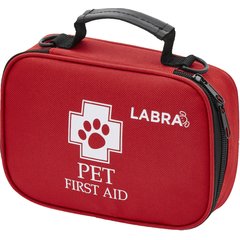6 Essential Tornado Safety Tips Pet Parents Should Know

Photo by Kerkez/iStock/Getty Images Plus
From toxic foods to illness to new experiences, we dutifully protect our furry friends from every potential threat that may come their way. And if you live in an area with dangerous weather—like tornadoes—then knowing how to keep pets safe from extreme storms is a priority as well.
Here’s everything you need to know about tornado safety, including how to prepare in advance, what action to take once you hear warning sirens, and how to help your pet stay calm and secure during a scary storm.
1. Update Your Pet’s Microchip
Unlike collars or tags that can fall off or get removed, microchips provide a reliable, tamper-proof way to identify your pet for life, says Sarah Cortright, DVM, veterinarian and chief medical director for the Underdog Community Project in Orange County, California.
A pet microchip is about the size of a grain of rice and sits just underneath the skin. Many humane societies microchip pets as part of their usual protocol, but this is also something you can have your veterinarian do.
Throughout your pet’s life, you’ll need to update the microchip to ensure your contact information is current. Dr. Cortright stresses the importance of this, noting that it’s the best way to reunite with your pet if you’re separated during a tornado, storm, or otherwise.
2. Build an Emergency Kit for Your Pet
A pet emergency kit ensures you’re prepared for inclement weather heading your way. Sharon Hawa, senior manager of emergency services for Best Friends Animal Society, recommends keeping the following together in a bag (or bags):
- Leashes and collars or harnesses with a current ID tag that includes your phone number
- Pet first aid kit, like this easy-to-grab bag that’s stocked with essentials
- Crates/carriers with bedding, blankets, or towels
- Food in an airtight and waterproof container
- Water (plus collapsible bowls)
- Your pet’s favorite toys and treats
- Litter, a small disposable litter box, and/or waste bags
- Your pet’s medications with instructions in a waterproof container
- One-month supply of flea, tick, heartworm prevention in a waterproof container
- Grooming items
- Recent photographs of your pets
Recommended Products
It’s also important to have your pet’s vaccination and medical records handy, including their microchip number and prescriptions for medications, inside a sealed waterproof bag.
3. Run a Tornado Drill
In the same way we practice for emergencies with fire or tornado drills, it’s important to do a couple run-throughs with your pet to ensure all goes well and that you’re fully prepared.
“Can you gather your pets and supplies in under five minutes? Practice getting cats into carriers and dogs into their safe space so it’s less stressful during the real thing,” Dr. Cortright says.
During the drill, go through your bag to make sure you have everything you need on hand and add to your emergency kit as needed.
4. Be Aware of Incoming Weather and Act Quickly
There are two alerts you’ll likely receive from local officials: a tornado watch and a tornado warning:
- A tornado watch means severe weather conditions will likely produce tornadoes in the area.
- A tornado warning means that tornadoes have been spotted or detected by radar and there is a serious and immediate threat in the area.
“Do not wait for a tornado warning to be made by local officials. If you are under a tornado watch, start making your way to a safe spot in your home,” Hawa says. “That may allow the time you need to collect your pets and essential supplies and get to safety before the tornado warning.”
Pro Tip: If your county offers mobile emergency notification alerts, sign up to receive text messages during emergency events.
5. Find Shelter and Secure Your Pet
The safest place during a tornado is a basement or an underground shelter. If you don’t have access to this, then the next best thing is a windowless interior room on the lowest level of your home—like a bathroom or closet.
“Your pet should be secured in a crate or carrier, if possible,” Dr. Cortright says. “This protects them from flying debris and prevents them from bolting in fear. If you don’t have time to crate your dog, use a sturdy leash and harness to keep them close and under control.”
She adds that cats should always be in carriers. They easily become frantic and nearly impossible to catch during chaos.
Stay sheltered until the storm threat has completely passed. If your pet shows signs of anxiety—such as pacing, panting, or hiding—try to stay as calm as possible yourself. (Pets are sensitive to your emotions!)
6. Remain Cautious After the Storm
Tornadoes can cause enormous damage, even if your area wasn’t in the twister’s direct path. Remain cautious when venturing outside to assess damage post-storm.
“Gas and power lines may be down and can be hazardous to humans and animals,” Hawa says. “Do not let animals loose or allow them to wander, as the debris field left from a tornado could also be dangerous.”
Keep your pet leashed or crated and by your side at all times. Soothe them with gentle reassurance along with their favorite toy, blanket, and/or treats.
Attributions
This content was medically reviewed by Jo Cornett, DVM, Chewy veterinarian.






